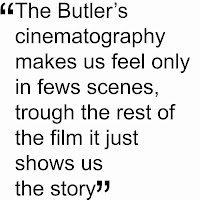Director Lee Daniels' (Precious, The Paperboy, Shadowboxer) last feature is The Butler, a film, inspired by a true story, very promising due to the cast and the theme it deals with.
The plot. Cecil Gaines manages to make his way from a domestic servant up to a butler in the White House, serving 8 different presidents and witnessing important momentums in History which reflect the stability of his familiar life.
Camera: Arriflex 435, Panavision Panaflex Platinum
Lenses: Panavision Primo, Angenieux Optimo
Aspect ratio: 1.85:1
Format: 35mm
Film Stock: Kodak Vision 5203 50D, Vision 5207 250D, Fuji Eterna Vivid 8543 160T, Eterna 8563 250D, Eterna 8573 500T
After the Oscar winning Precious, Lee Daniels repeats with Andrew Dunn (Hitch, Crazy Stupid Love, Gosford Park) as cinematographer to shoot The Butler. He is very fond of film stock as, according to his own words, film is the real HD, so he obviously chose this format for The Butler, using different stocks for better suiting different situations and periods of the story.
The film doesn't have a straight light approach: its lighting differs from scene to scene and changes with a story that unfolds during 80 years. It has an overall natural feel but suddenly the light changes to theatrical when drama needs to be transmitted, with strong back lights or side lights as Key lights which sometimes has a blue cast, like the scene of the hanged people or the butler's son first kiss.
Forest Whitaker´s character is a butler that has to serve in a room in a silent way, be discrete and avoid letting feel his presence; I like the way Andrew Dunn showed this concept visually: by composition, by placing the actor always aside, almost as en extra passing by, as he'd been forgotten, and by lighting, lit with the fall off of the main light of the scene lighting the president and his men or leaving him 1/2 stop or a stop underexposed than the other characters.
During the scenes in the White House lighting and way of shooting are academic, neat and precise, while outside Dunn allows himself to be more artistic, for example by combining archive footage with own footage shot on Kodak 5207 250D manipulated in post production to match the original one. But the way of shooting stays formal throughout the film.
Different diffusion filters were used on the lens to make the film less perfect and getting the audience into the story, but also to define the different periods of the story: as we can see different gradations were used, the strong diffusion for the flashbacks gradually gets softer as the story draws on in the years till the present days, where no diffusion filter is used.
It sounds to me a too much obvious solution as it is the strong yellow cast, psychologically associated to family, used in the scenes of the butler's home.
 Camera barely moves limiting itself to witness the story developing in front of the lens: we always know were we are and what we have to look at. Once again an academic way of shooting. Focal lens choice is pretty correct, though I missed the use of tilt shift lenses in a couple of shots where I found converging lines too disturbing.
Camera barely moves limiting itself to witness the story developing in front of the lens: we always know were we are and what we have to look at. Once again an academic way of shooting. Focal lens choice is pretty correct, though I missed the use of tilt shift lenses in a couple of shots where I found converging lines too disturbing.
The Butler is a film which stands only for the theme it deals with and it is interesting for whom is not aware of the social fight held in USA in the last decades but it is a bit too cold and distant and limits itself to witness all the happenings and changes of those years because we barely empathize with characters. Its cinematography reflect this distance: apart from few scenes, it shows us the story rather than making us feel something.
No comments:
Post a Comment